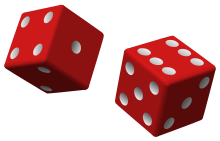Random number

A random number is generated by a random (stochastic) process such as throwing Dice. Individual numbers can't be predicted, but the likely result of generating a large quantity of numbers can be predicted by specific mathematical series and statistics.
Algorithms and implementations
[edit]Random numbers are frequently used in algorithms such as Knuth's 1964-developed algorithm[1] for shuffling lists. (popularly known as the Knuth shuffle or the Fisher–Yates shuffle, based on work they did in 1938).
In 1999, a new feature was added to the Pentium III: a hardware-based random number generator.[2][3] It has been described as "several oscillators combine their outputs and that odd waveform is sampled asynchronously."[4] These numbers, however, were only 32 bit, at a time when export controls were on 56 bits and higher, so they were not state of the art.[5]
The Fisher-Yates shuffle (or Knuth shuffle) is an algorithm developed in 1938 and popularized in 1964 for shuffling lists using random numbers. In 1999, Intel added a hardware-based random number generator to the Pentium III, which combined oscillator outputs to generate random numbers. However, these numbers were 32-bit, considered less advanced at the time due to export controls on higher bit lengths (56 bits and above).
Common understanding
[edit]In common understanding, "1 2 3 4 5" is not as random as "3 5 2 1 4" and certainly not as random as "47 88 1 32 41" but "we can't say authoritavely that the first sequence is not random ... it could have been generated by chance."[6]
When a police officer claims to have done a "random .. door-to-door" search, there is a certain expectation that members of a jury will have.[7][8][example needed]
In common understanding, sequences like "1 2 3 4 5" seem less random compared to "3 5 2 1 4" or "47 88 1 32 41", but it's important to note that we can't definitively say the first sequence is not random—it could have occurred by chance. Similarly, when a police officer claims to have conducted a "random door-to-door" search, jurors may have certain expectations about how randomness is perceived in that context.
Real world consequences
[edit]Flaws in randomness have real-world consequences.[9][10]
A 99.8% randomness was shown by researchers to negatively affect an estimated 27,000 customers of a large service[9] and that the problem was not limited to just that situation.[clarification needed]
Flaws in randomness can have significant real-world impacts. For example, researchers found that a randomness rate of 99.8% led to negative consequences for an estimated 27,000 customers of a large service. This issue was not isolated and had broader implications in other situations as well.
See also
[edit]- Algorithmically random sequence
- Quasi-random sequence
- Random number generation
- Random sequence
- Random variable
- Random variate
- Random real
References
[edit]- ^ Richard Durstenfeld (July 1964). "Algorithm 235: Random permutation". Communications of the ACM. 7 (7): 420. doi:10.1145/364520.364540.
- ^ Robert Moscowitz (July 12, 1999). "Privacy's Random Nature". Network Computing.
- ^ "Hardwiring Security". Wired. January 1999.
- ^ Terry Ritter (January 21, 1999). "The Pentium III RNG".
- ^ "Unpredictable Randomness Definition". IRISA.
- ^ Jonathan Knudson (January 1998). "Javatalk: Horseshoes, hand grenades and random numbers". Sun Server. pp. 16–17.
- ^ Tom Hays (April 16, 1995). "NYPD Bad Cop's Illegal Search Mars Career". Los Angeles Times.
- ^ A pre-compiled list of apartment numbers would be a violation thereof.
- ^ a b John Markoff (February 14, 2012). "Flaw Found in an Online Encryption Method". New York Times.
- ^ Reid Forgrave (May 3, 2018). "The man who cracked the lottery". New York Times.
